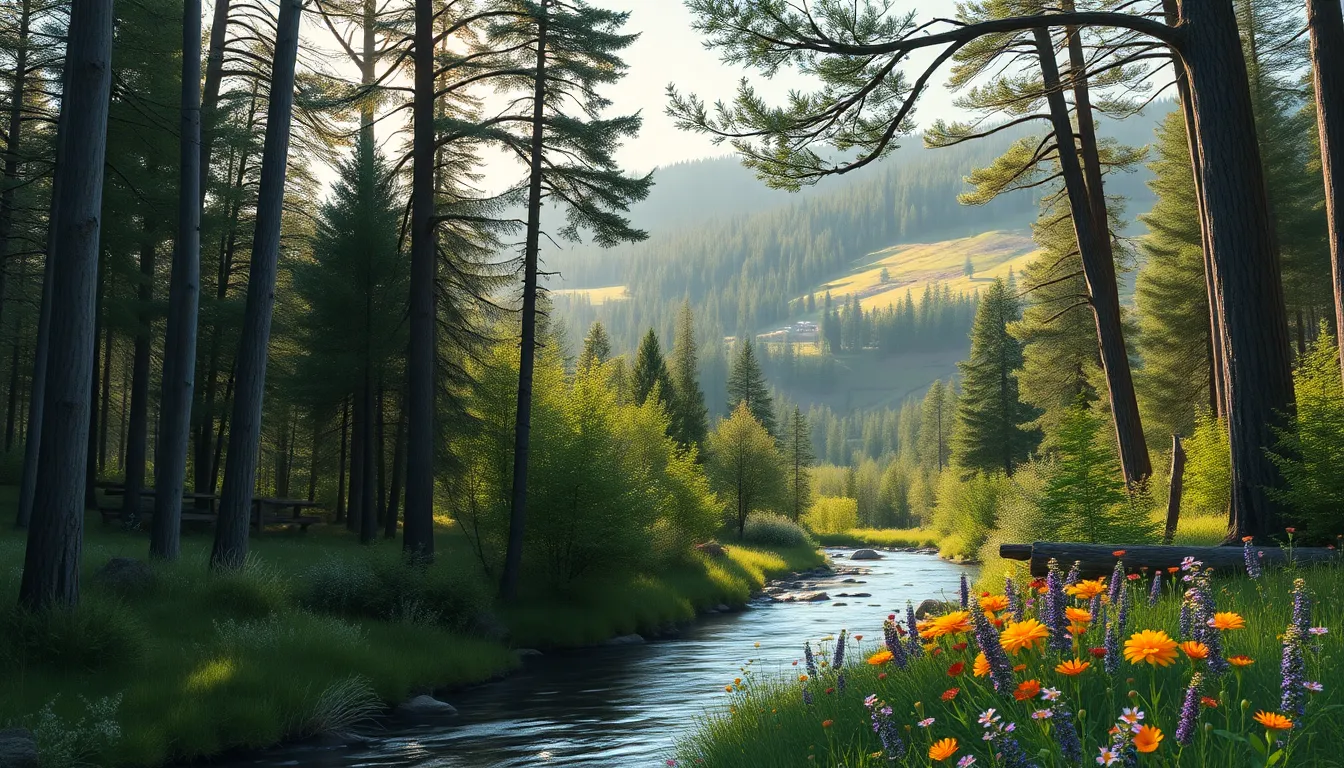Imagine waking up to the gentle rustle of leaves and the sweet serenade of chirping birds. A home in the woods isn’t just a place; it’s a lifestyle choice that invites tranquility and adventure right to your doorstep. Who needs a noisy city when you can have nature’s symphony as your morning alarm?
Living in the woods offers more than just stunning views; it’s a chance to reconnect with the simple joys of life. Picture cozy evenings by the fireplace, surrounded by the beauty of towering trees and starry skies. It’s like living in a fairy tale—minus the dragons, of course. So if you’ve ever dreamed of trading concrete jungles for lush greenery, this guide will explore why a home in the woods might just be your perfect escape.
Table of Contents
ToggleThe Allure of a Home in the Woods
A home in the woods offers unparalleled tranquility. Living surrounded by nature provides a peaceful alternative to the noise of urban life. Each morning begins with the gentle sounds of birds singing or leaves rustling in the breeze.
Serene landscapes inspire creativity and relaxation. Homeowners enjoy private views, lush greenery, and diverse wildlife. Those seeking adventure find opportunities for hiking, biking, or exploring nearby trails. Each season brings unique experiences, from vibrant wildflowers in spring to snowy wonderlands in winter.
Privacy constitutes another essential aspect of this lifestyle. Often, homes sit on large plots of land, offering ample space to breathe and unwind. This separation from neighbors leads to a peaceful atmosphere, fostering a profound connection to nature.
Comfort and warmth emerge by cozying up to a roaring fireplace after a day outdoors. Evenings under the stars provide a perfect backdrop for gatherings or solitary reflection.
A home in the woods fosters a sense of community among those who share similar lifestyles. Many rural areas offer local events that celebrate outdoor living, enhancing neighborly bonds.
Sustainability often plays a role in these homes. Many residents adopt eco-friendly practices like solar energy or organic gardening.
Ultimately, the allure of a home in the woods captures hearts and minds alike. Embracing this lifestyle allows individuals to escape city constraints and immerse themselves in nature’s beauty.
Finding the Perfect Location

Selecting a location for a home in the woods requires careful consideration of various factors. Each element contributes to the overall experience of living in such a serene environment.
Evaluating Land Features
Evaluating land features ensures that the property meets specific needs. Assessing topography is vital; flat land can facilitate building, while hilly terrain may provide stunning views. Soil quality plays a role too; fertile soil supports gardening efforts and landscaping. Water sources such as streams or ponds enhance relaxation and recreational opportunities. Dense trees provide privacy and shelter; understanding their types allows for better planning in terms of maintenance and aesthetics. Wildlife presence can enrich daily life; observing various animals fosters a connection to nature. Exploring these features helps homeowners make informed decisions about their future in the woods.
Accessibility and Proximity
Accessibility must not be overlooked when selecting a location. Proximity to amenities can balance the tranquility of living in the woods with practical requirements. Major roads should remain nearby to facilitate commuting; this saves time for trips to grocery stores and healthcare facilities. Public transportation options could simplify travel for those without personal vehicles. Nearest towns or cities can offer social interactions and entertainment opportunities; ensuring they are within a reasonable distance enhances convenience. Additionally, local community resources contribute to a sense of belonging; engaging with neighbors fosters connections in a peaceful setting. Evaluating these factors improves the overall living experience in a woodland home.
Designing Your Dream Cabin
Designing a cabin in the woods focuses on harmony with the natural surroundings. It creates a seamless living environment where the house enhances the beauty of its setting.
Integrating with Nature
Maximizing sunlight in cabin design enhances warmth and comfort. Large windows showcase forest views and bring the outside in. Using decks or patios encourages outdoor living, allowing for easy access to nature. Landscaping with native plants provides habitat for local wildlife. Choosing a layout that aligns with the natural topography respects the land’s contours and reduces disruption. Incorporating natural materials in the aesthetic can create a cohesive feel with the environment. Designing pathways that meander through the property allows exploration without damaging ecosystems.
Sustainable Building Materials
Selecting sustainable materials significantly impacts environmental footprint. Reclaimed wood offers charm while minimizing deforestation. Local stone not only supports local economies but also blends naturally with the landscape. Bamboo, a rapidly renewable resource, provides strength and sustainability. Using low-VOC finishes promotes healthier indoor air quality. Energy-efficient windows reduce heating and cooling costs, making homes more efficient. Solar panels provide renewable energy, further enhancing sustainability. Prioritizing these materials creates a cabin that embraces eco-friendly principles while embodying style and comfort.
Embracing the Lifestyle
Living in the woods invites individuals into a lifestyle rich with nature’s embrace and outdoor escapades.
Outdoor Activities and Recreation
Outdoor adventures abound for those in woodland settings. Hiking trails wind through forests, offering stunning vistas and exercise. Biking enthusiasts find endless paths, perfect for exploring. Fishing in nearby streams provides relaxation and an opportunity to connect with the environment. Wildlife observation captivates residents, with opportunities to see deer, birds, and other creatures daily. Many embrace seasonal activities like snowshoeing in winter and swimming in summer. Each experience deepens the bond with nature, transforming leisure time into cherished experiences.
Connection to Nature and Wildlife
Living amidst nature fosters a profound connection to wildlife. Sounds of chirping birds and rustling leaves create a daily symphony. Direct encounters with local fauna enrich life, offering lessons in biodiversity. Wildlife-friendly habitats, such as gardens, attract pollinators and other species, enhancing ecosystems. Observing animal behaviors develops appreciation for nature’s intricacies. Each season brings unique sights, scents, and experiences that celebrate the changing environment. Embracing this lifestyle encourages stewardship of local habitats, promoting sustainability and respect for the earth.
Challenges of Living in the Woods
Living in the woods brings unique challenges that prospective homeowners must consider. Weather can significantly impact daily life and the overall living experience.
Weather Considerations
Snow can blanket the area during winter months, creating beautiful scenery but also complicating access to the home. Rainy seasons may lead to mudslides or flooding, necessitating proper drainage solutions. Isolation can occur during extreme weather events, limiting travel and communication. Being prepared for sudden temperature drops is essential for comfort. Understanding local climate patterns helps homeowners plan for seasonal changes and adapt if necessary.
Maintenance and Upkeep
Regular maintenance is crucial for preserving a woodland home. Trees and vegetation require trimming to prevent damage to structures. Pests, such as termites or rodents, can pose significant threats if left unchecked. Homes in remote areas often require more frequent inspections for mold or mildew due to humidity levels. Outdoor areas demand attention, including gardening and trail upkeep, to ensure enjoyment and safety. Staying proactive about upkeep can mitigate long-term issues, preserving the beauty of the woodland setting.
Choosing a home in the woods opens the door to a lifestyle rich in peace and adventure. Surrounded by nature’s beauty and tranquility, residents can enjoy a deeper connection to the environment and a simpler way of life.
While there are challenges to consider, such as weather and maintenance, the rewards often outweigh the drawbacks. The chance to engage in outdoor activities and embrace sustainability creates a fulfilling experience that urban living can’t match.
Ultimately, a woodland home represents not just a place to live but a way to thrive in harmony with nature. For those seeking an escape from city life, it offers a unique opportunity to reconnect with the joy and serenity that only the woods can provide.



